Barcode Scanning Systems: A Key to Modern Warehouse Operations
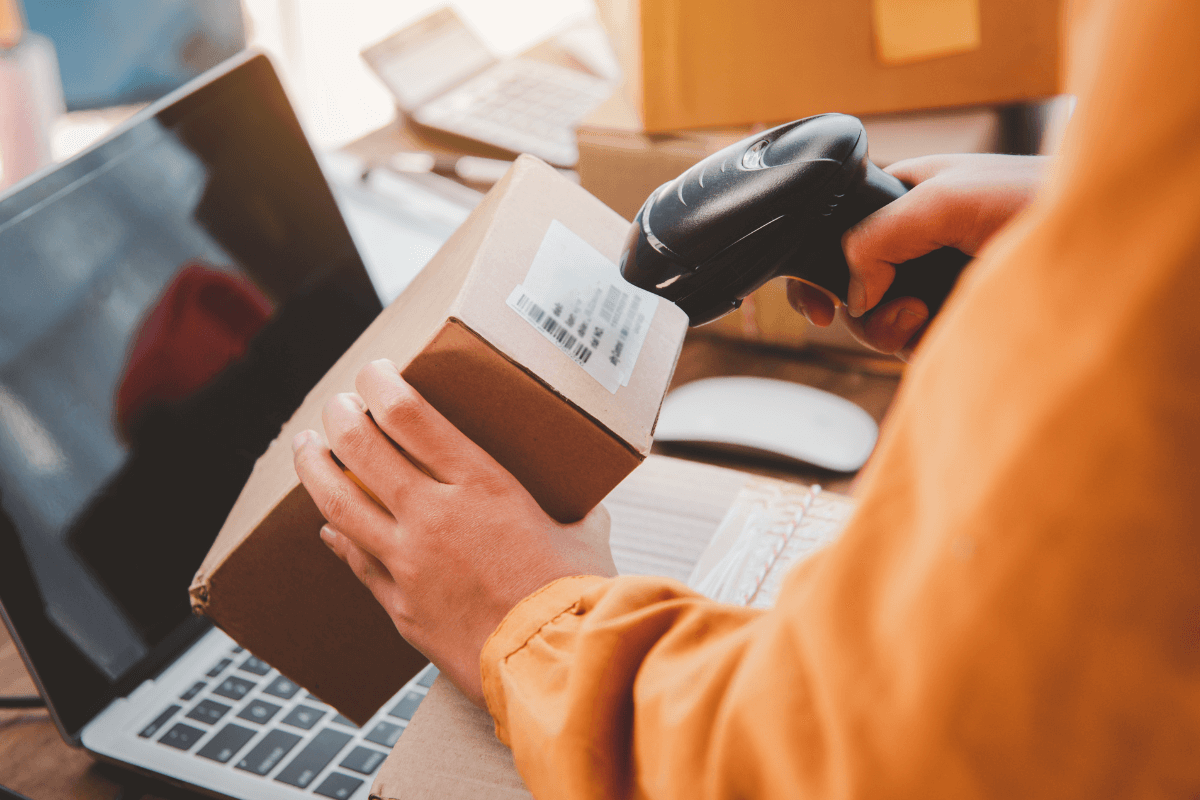
The bottom line of any business is heavily influenced by the efficiency of its operations. That’s very true when we speak about warehouses. How do you maintain a record of all the goods in your warehouse? Effective warehouse management translates to higher profits and faster turnaround times, which ultimately result in happy customers and off-the-top sales. But if your warehouse looks more like a labyrinth of misplaced items, you urgently need a reliable agriculture software development solution to bring order to the chaos. A barcode scanning system for a warehouse can be the solution you need.
Honestly, warehouse barcode scanning remains one of the most popular technologies for inventory management efficiency. Industry projections indicate a massive 38% surge in barcode scanner adoption by 2028, with 97% of supply chains expected to be on board. Yes, the warehouse barcode scanning system is worth your attention, and we’re going to prove it in this blog.
The Role of Barcode Scanning Systems in Warehouses
Supply chains are under immense pressure to deliver impeccable accuracy and lightning-fast order fulfillment. Paper-based, manual management simply cannot keep up. The modern warehouse is a high-stakes arena that demands real-time visibility, optimized material flow, and a relentless pursuit of efficiency.
Warehouse barcode scanning software is the technology capable of giving you the edge warehouses seek. How this solution can automate your operations, and what is the true benefit of barcode scanning for warehouse management? Let’s figure it out together.
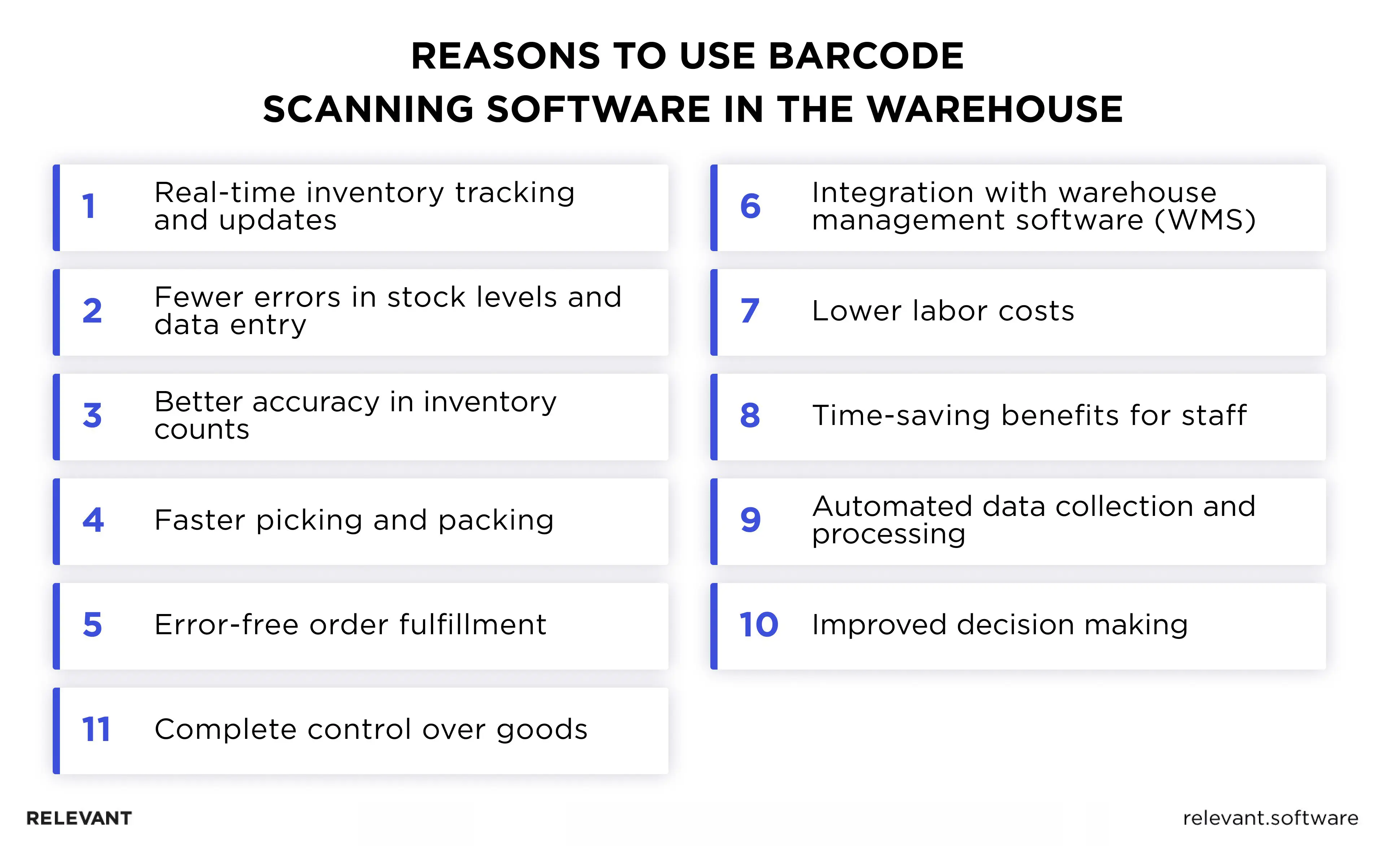
Real-Time Inventory Tracking And Updates
One of the main reasons companies implement barcode systems is real-time inventory turnover visibility. Every time a product is received, stored, picked, or shipped, its storage location and quantity are updated instantly.
A barcode scanning system for a warehouse also facilitates batch tracking, which means you can monitor groups of items with the same production batch throughout the entire supply chain. With live status updates, you don’t need to count manually while the risks of stockouts or overstocks are cut to a minimum. By the way, IoT applications in agriculture likewise enhance visibility and control over crop production and livestock management.
Reducing Errors In Stock Levels And Data Entry
Humans make mistakes, especially when faced with the monotonous task of entering data. Barcoding takes human error out of the equation. Since the barcode scanning system for a warehouse automatically collects data and updates inventory records, you can trust the accuracy of your safety stock levels and avoid costly discrepancies.
Improved Accuracy In Inventory Counts
Counting inventory items by hand is about as exciting as watching paint dry—and it’s prone to errors. Barcode scanning warehouse systems make this process faster and far more accurate. With just a quick scan, you can count items in a fraction of the time it used to take and with much higher accuracy.
Faster Picking And Packing Processes
When a worker needs to find an item, they simply scan the QR code using a handheld scanner or mobile device. The system instantly retrieves the item’s exact warehouse location within the warehouse, guiding the worker directly to where the item is stored. Less time spent searching for products allows workers to speed up order picking, which also means faster order fulfillment and more satisfied customers.
Minimizing Errors In Order Fulfillment
There’s nothing worse than sending a customer the wrong item. It’s frustrating for them and costly for you. Thanks to a barcode scanning system in a warehouse, it’s easier to check whether the right products are picked and shipped for every customer. You can cross-reference scanned items with orders, reducing the risk of customer returns.
Integration With Warehouse Management Systems
You likely use some applications and systems to run your warehouse. A warehouse barcode scanning system easily integrates with a warehouse management system (WMS) and similar solutions, which is important for maintaining a seamless workflow and ensuring that all your data is synchronized across platforms. Due to this, you can gain complete control over the inventory and better reporting.
Reduction In Labor Costs
Warehouse barcode scanning automates many tasks and reduces the labor required for inventory management, order picking, and packing. It lets your employees accomplish more with less time. With fewer people needed to perform repetitive tasks, you can decrease labor costs while still maintaining the same level of efficiency.
Minimization Of Losses Due To Errors And Misplacements
Human error is inevitable, but barcode technology can drastically cut its impact. It increases the accuracy of data capture and enables real-time tracking capabilities, which brings the risk of misplaced items down to the minimum. No more inventory discrepancies or order fulfillment mistakes, which ultimately lower financial losses.
Time-Saving Benefits For Warehouse Staff
Barcode scanning warehouse software saves precious minutes (or even hours) off routine tasks such as inventory counts, order picking, data entry, etc. Instead of being burdened with mundane, repetitive tasks, your staff can have more time to do higher-value activities and increase their productivity.
Automated Data Collection And Processing
A barcode scanning system for a warehouse completely eliminates the need for manual data entry because it gathers and stores all the information:
- Product information: product ID, description, size, color, and other relevant details.
- Quantity: The number of items scanned.
- Location data: The specific location of the item within the warehouse (e.g., aisle, shelf, bin).
- Transaction data: Information about the movement of the product, such as when it was received, picked, packed, or shipped.
- User information: Details about the employee who scanned the barcode labels.
Obviously, it decreases the probability of human error and saves time. Moreover, the collected data then flows into WMS for further processing and analysis.
Improved Decision-Making Through Data Analytics
Good decisions are based on good data, and a warehouse barcode system provides just that. With accurate, real-time information automatically collected and processed, you can dive into data analytics with confidence. For example, data on the most sold products to particular regions will give you insights into customer preferences and demand patterns or identify opportunities for product expansion. In the same way, you’ll be able to track inventory trends and detect bottlenecks, making more informed decisions. IoT and AI solutions used in agriculture can do even more wonders in data analysis and predictions.
Control Over Access And Movement Of Goods
A barcode scanning system for warehouse is an ideal solution for tracking the movement of goods within and beyond the warehouse. This allows you to monitor products and know who is handling what and where the goods are at any given time. With such tight oversight, the risks of theft or loss are minimal, and you can rest easy knowing that every product is exactly where it should be.
Types of Barcode Scanning Systems
Whether you’re looking to boost efficiency, improve accuracy, or simply make your team’s job a little easier, there’s a warehouse barcode scanning system that’s right for you. Below, we review the most common barcode scanner types that fit different purposes.
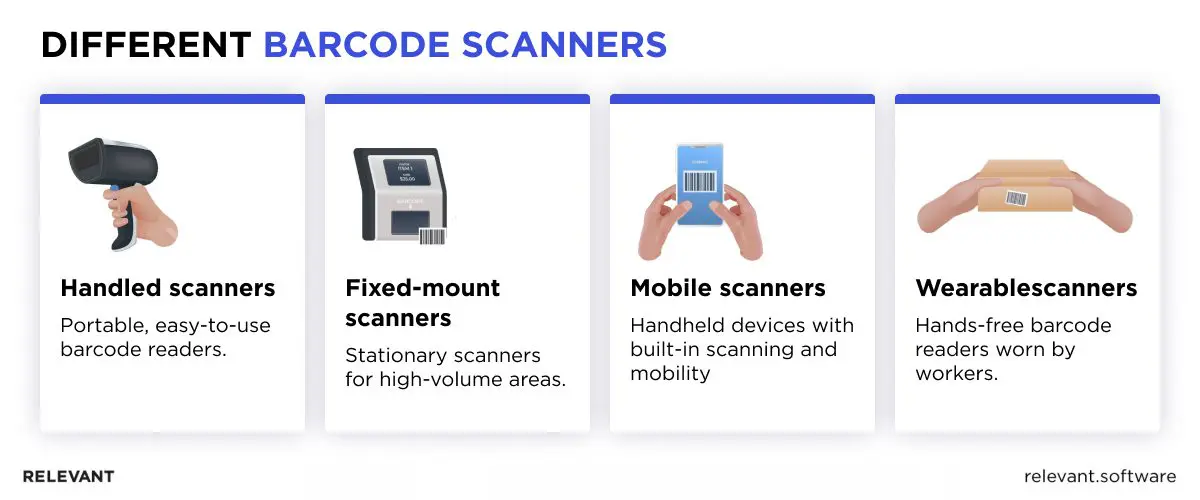
Handheld Scanners
Handheld scanners are the most common type used in warehouses. They are compact and comfortable to hold in the hand, which makes barcode scanning of a product of any size and shape convenient. These devices are easy to use, carry with you everywhere, and perfect for quick, on-the-go scanning.
Features and Benefits:
- Portability: Lightweight and easy to carry, allowing workers to scan items wherever they are.
- Flexibility: Can read a unique barcode from various angles and distances, making them ideal for different types of products and packaging.
- Durability: Designed to withstand the bumps and drops that come with a busy warehouse environment.
In fact, they accommodate the different warehouse scenarios, including general inventory management, order picking and fulfillment, shipping and receiving, and returns processing due to their mobility. In short, this type is a reliable, all-purpose scanner for agriculture warehouse needs.
Fixed-Mount Scanners
These are stationary devices, typically installed in high-traffic areas like conveyor belts or checkout stations, as they are good at managing high-volume scanning volumes. They’re commonly used in sorting facilities, automated picking lines, or any scenario where products need to be scanned continuously without human intervention.
Benefits:
- High-Speed Scanning: Capable of scanning hundreds of items per minute, making them perfect for high-volume areas.
- Automation technologies: Reduces the need for manual scanning, freeing up workers for other tasks.
- Consistency: Provides reliable, consistent scanning in fast-paced environments where manual errors are not an option.
Mobile Computers with Integrated Scanners
Mobile computers combine the functionality of a handheld computer with a built-in barcode scanner. Therefore, we can say they are multitasking tools that let workers accomplish several activities from a smartphone. For instance, a warehouse manager might use one to check inventory accuracy, update records, and communicate with the team—all while scanning products.
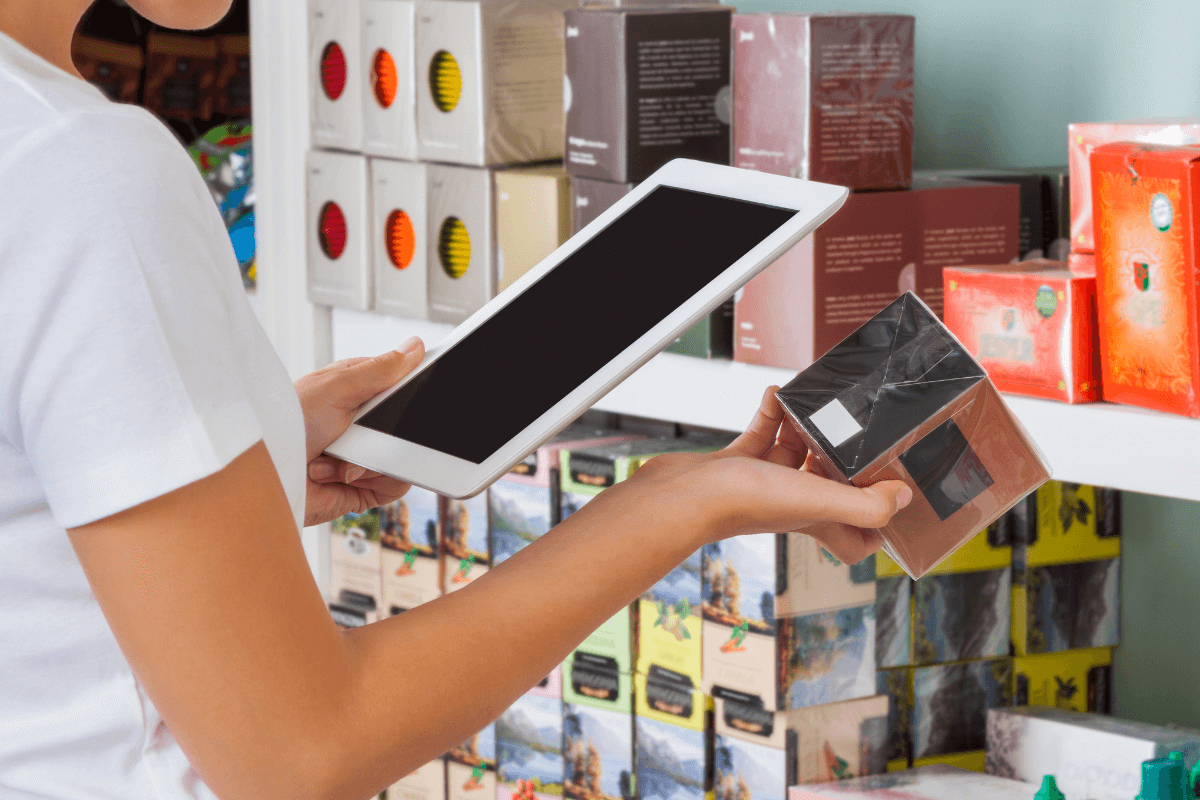
Wearable Barcode Scanners
Wearable barcode scanners are the smallest, lightweight, and unobtrusive devices, typically mounted on a worker’s wrist, finger, or arm. The most common are rings, smart glasses, or wristbands. They offer hands-free scanning capabilities which don’t limit worker’s moves. This enhances employee productivity and reduces fatigue, as workers can scan items effortlessly while performing other tasks.
Implementing a Barcode Scanning System for a Warehouse
Any new technology or software adoption needs proper planning, the right tools, and certainly flawless execution. If you decide to implement barcode scanning in warehouse, follow these steps Relevant experts outlined to simplify the process.
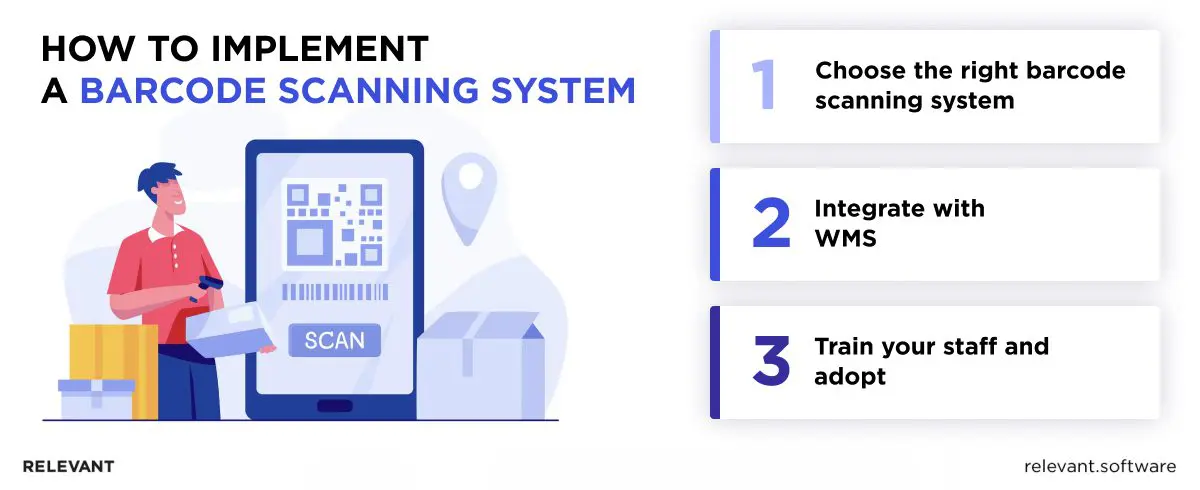
Choosing the Right Barcode Scanning System
The first thing you should do is determine what kind of warehouse barcode scanning will better suit your specific needs and workflow. To do that, compare the available options based on a few key factors.
- Type of products: First, think about the type of products you handle. Are they large and bulky, or small and delicate? Their shape and material will likewise influence whether you choose handheld scanners or wearable scanners.
- Warehouse layout: Next, consider your warehouse layout. If your facility has narrow aisles and high shelves, you might need scanners with long-range capabilities or those that can capture barcodes from awkward angles.
- Volume of transactions: Finally, the number of items you handle daily will impact the required scanning speed and capacity.
When you make it clear what type of barcode scanning system for a warehouse you need, conduct a thorough cost-benefit analysis to justify the investment and measure the return on investment (ROI). Sure, it costs some money upfront, but like any investment, it pays for itself in the long run. The time saved on manual data entry and fewer errors will lower operational costs and increase employee productivity. That’s what every warehouse manager and business owner seeks.
Integration with Warehouse Management Systems (WMS)
Now, what you want is a barcode scanning system for a warehouse that communicates easily with the inventory management system you use. Otherwise, there would be no point in investing in a new technology.
So, how do barcode systems integrate with WMS? Shortly, through APIs or other middleware solutions. These are the easiest and sure ways to enable real-time data exchange between the two systems. Thanks to APIs, when a barcode is scanned, the unique characteristics—such as product ID, quantity, and location—are instantly transmitted to the WMS, where it is processed and reflected in the inventory management software.
With seamless data flow between the systems, you can automate many of the manual processes that slow down operations. You can accelerate order processing, have more accurate inventory levels, and be able to track products as they move through your warehouse in real-time.
Training and Adoption
The introduction of new technology can be intimidating for employees since they’re used to doing their jobs the old-fashioned way. To help your staff feel comfortable and confident using a new barcode scanning system for a warehouse, you should organize some training. It’s vital to educate your employees not only on the way scanners work but also introduce the benefits of it and tell how the technology fits into their daily tasks.

Adopting new technology doesn’t have to be a painful process. Involve your team early on—get their input, address their concerns, and make them feel like they’re part of the transition. You can also roll out the system in phases, starting with a pilot program before full implementation. This allows your team to gradually familiarize themselves with the new powerful tool, resolving any issues that arise.
Our Case Study: Barcode Scanning App For Streamlining Berry Picking
We know so much about the benefits and positive outcomes of a barcode scanning system for a warehouse from our clients, who turned to Relevant Software for help. We want to show you how things may change for the better with a warehouse barcode scanning solution on the example of one of our successful projects.
Barcode scanning app for streamlining berry picking
Wish Farms, one of the largest berry suppliers in the United States, approached Relevant to develop a barcode-scanning mobile app that would digitize the berry-picking process. The main requirements for the app were to make it operational under extreme weather conditions and ensure easy usage for workers wearing gloves.

Our team developed a custom React Native application tailored to Wish Farms’ specified needs. We concentrated on the app’s design and user experience to make the interface as intuitive and easy to navigate as possible, even with gloves and even under the glaring sun. The app’s scanner technology can handle thousands of barcodes per minute, which are instantly uploaded to the system. We also added a dedicated training mode that facilitates smooth onboarding for new employees.
The outcome for Wish Farms became the long-awaited efficiency and quick data capture with zero errors, which resulted in faster and smoother operations.
Barcode Scanning Systems Development with Relevant Software
While you’re trying to keep up with the modern pace of consumer demands and complex logistics by conducting your warehouse operations manually, many business owners and quite possibly your competitors too use a barcode scanning system for a warehouse. The technology is capable of speeding up picking, packing, dispatching, and other important activities so you can gain the operational efficiency you may need.
If you’re ready to embrace improved warehouse performance and better customer satisfaction but don’t want to deal with technical details, partner with Relevant. Here, you’ll find tech experts, business analysts, and designers who are professionals and who are deeply interested in solving your problem through software development. We have successfully accomplished several projects for warehouses, including warehouse barcode scanning solutions, so we definitely know how to help you. Contact us to get a consultation.



